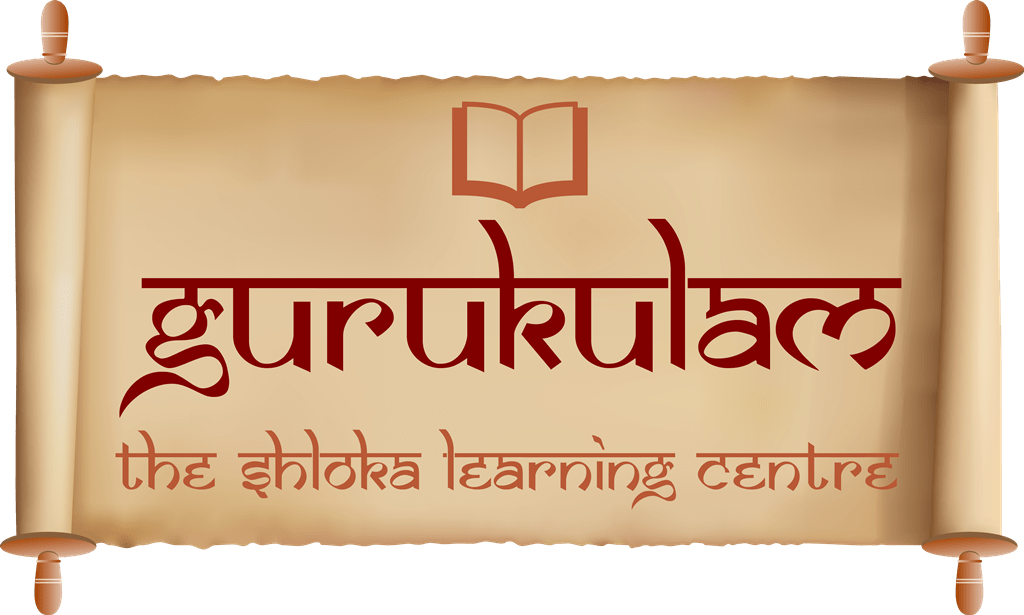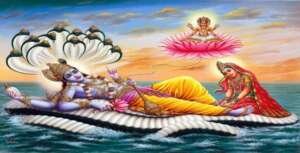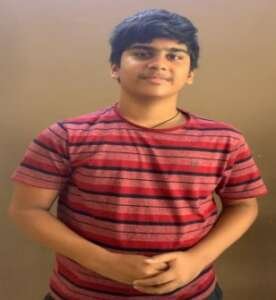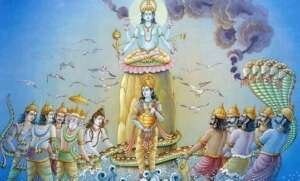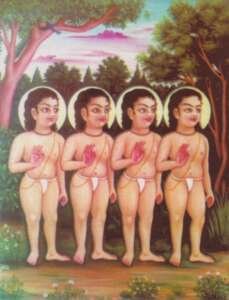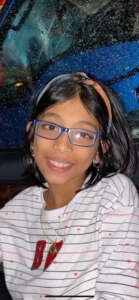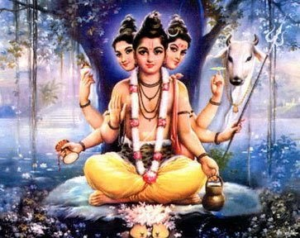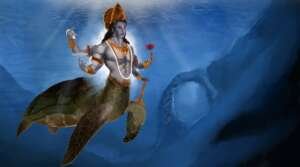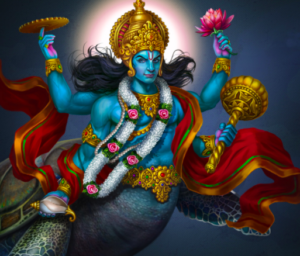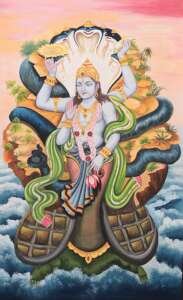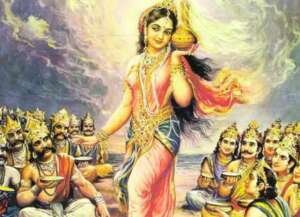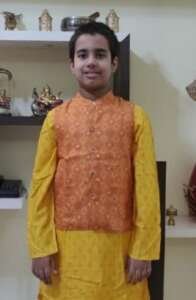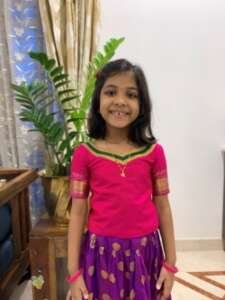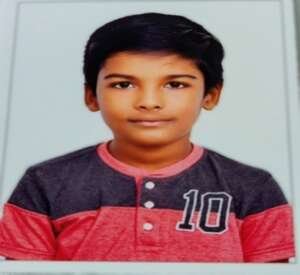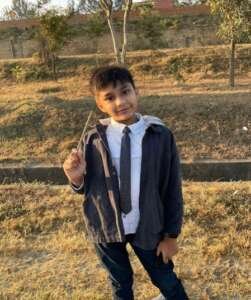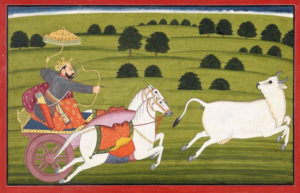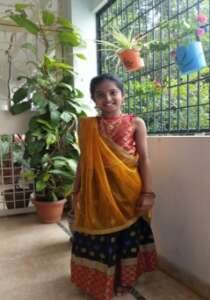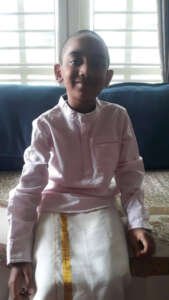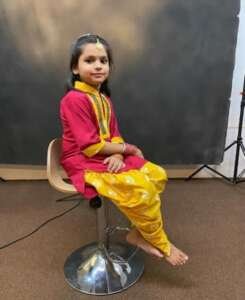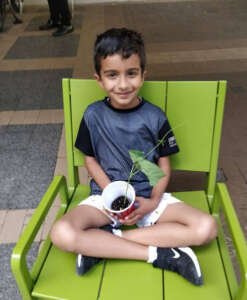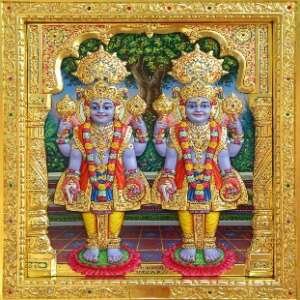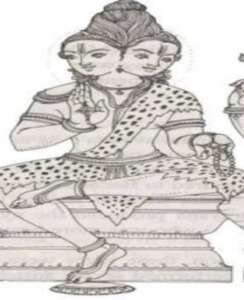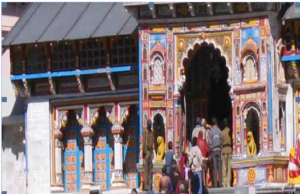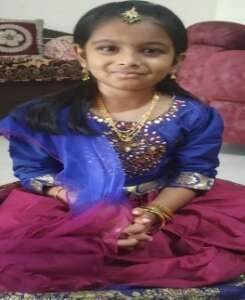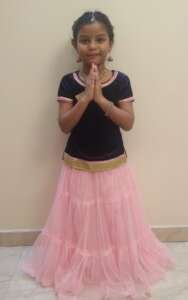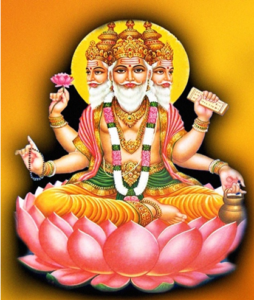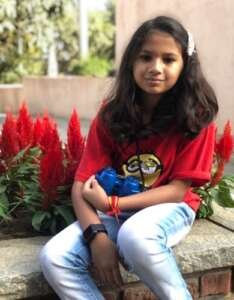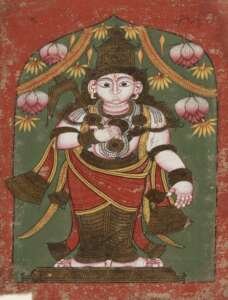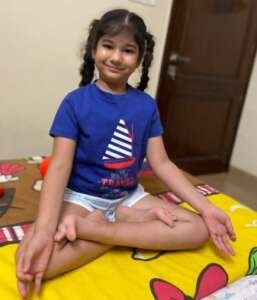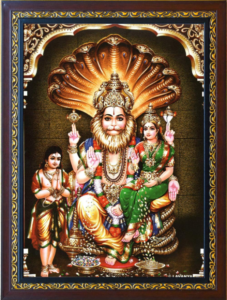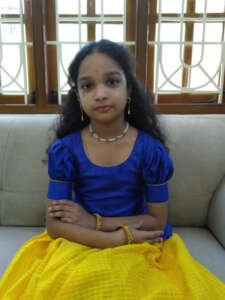THE AVATARS OF LORD VISHNU
Vishnu is the preserver and protector of the universe.
His role is to return to the earth in troubled times and restore the balance of good and evil. So far, he has been incarnated nine times, but Hindus believe that he will be reincarnated one last time close to the end of this world.
Lord Vishnu is having total of 24 Avatars from that the first Avatar is Adipurush (Adi means – beginning and Purush means – Man).
The Puranas mention that AdiPurush refers to the first incarnation of Lord Vishnu, who is regarded as the creator of the universe. It is believed that after creating the universe, He took his first incarnation as the pre-eminent man and is referred to as the first man of this universe, hence he is known as Adipurush. He is regarded as supreme and the epitome of goodness and righteousness. Over the years, He is believed to have taken various forms in order to kill evil and protect the universe.
Name: Yatin.N Class : 8
 Buddha or Gautama Buddha, is the ninth avatar among the ten major avatars of the god Vishnu. In contemporary Hinduism the Buddha is revered by Hindus who usually consider “Buddhism to be another form of Hinduism”.
Buddha or Gautama Buddha, is the ninth avatar among the ten major avatars of the god Vishnu. In contemporary Hinduism the Buddha is revered by Hindus who usually consider “Buddhism to be another form of Hinduism”.
For Buddhists, Buddha is not an avatar of Vishnu. For Hindus, he may be. Buddhism rose in India 2,500 years ago. It played a key role in spreading monastic ideas across the subcontinent.The Buddha was integrated into Vaishnavism through its mythology in the Vaishnava Puranas, where the Buddha is adopted as the ninth avatar of Vishnu.
His followers, known as Buddhists, propagated the religion that is known today as Buddhism.Buddha is not a name, but a title. It is a Sanskrit word that means “a person who is awake.”
Buddhism teaches that we all live in a fog of illusions created by mistaken perceptions and “impurities” — hate, greed, ignorance. A buddha is one who is freed from the fog. It is said that when a buddha dies he or she is not reborn but passes into the peace of Nirvana, which is not a “heaven” but a transformed state of existence.
DHRUV R SHAH
“Dhanvantari” – The Hindu god of medicine & Ayurveda and an incarnation of Lord Vishnu with four hands, holding restorative herbs in one hand and a pot containing energizing nectar called amrita in another. It is a common practice for worshipers to pray to Dhanvantari seeking his blessings for sound health.
According the Vedic puranas, Dhanvantari appeared from the Sea of Milk and showed up with the pot of nectar when the ocean was churned by the Devas and Asuras, using the Mandara mountain and the serpent Vasuki . The pot of Amrita was snatched by the Asuras and after this event, another avatar, Mohini, appears and takes the nectar back from the Asuras.
The birthday of Dhanvantari is celebrated as National Ayurveda Day in India by the practitioners of Ayurveda, two days before Diwali and it is written in the scriptures that, “One who remembers the name of Dhanvantari can be released from all disease.”
The Bhagvata Purana list the twenty-four avatars/ incarnations of Lord Vishnu and one of them is the “Four Kumaras”. Four Kumarswere the first four conscious beings created by Lord Brahma. Named Sanaka, Sanatana, Sanandana and Sanat Kumara, they appeared as infants and their purpose was to assist Brahma in creation of life.Brahma had created these four Kumaras so that they could help in the process of creation. But they refused and hence remained “kumaras” – kumara means unmarried brahmacaris.
Sanaka means ancient; Sanatana means joyful; Sanandana means eternal and Sanat Kumara means ever young. The Kumars represent truth, consciousness, wisdom and spirituality. With these qualities, they are known to be eternally liberated souls and are known to achieve all the yogic perfectional achievements ( siddhis ). It is believed that they travel in outer space without machines.The four Kumaras have their world asJana Loka or JanarLoka, but they always reside in the VAIKUNTA serving the Lord Vishnu/Krishna and always singing Hari manthra and praising Lord Vishnu.
This holy eighteen-syllabled mantra known as ŚrīGopāla Mantra was given by Lord Vishnu to the Four Kumaras and was, in turn, passed to the disciple of the Kumaras, Narada Muni.
By – Aaradhya G Pai
Dattatreya is one of the Avatars of Vishnu.
However he is known to be an incarnation of the Divine Trinity Brahma, Vishnu and Shiva.
The word Datta means “Given”, Datta is called so because the divine trinity have “given” themselves in the form of a son to the sage couple Guru Atri and Mata Anusuya. He is the son of Guru Atri, hence the name “Atreya.”
Dattatreya was a Monk, a member of a religious group of men who live in a special building (monastery) and do not get married or have possessions.
What are the powers of Lord Dattatreya?
Since Lord Dattatreya is the combined form of Lord Brahma, Vishnu and Shiva – the Hindu trinity, this form is a highly powerful one in blessing the devotees with abundance, prosperity and happiness. Chanting this mantra can help in attaining all the desires of an individual.
What does the three heads of Dattatreya represent?
The historic Indian literature has interpreted the representation of Dattatreya symbolically. His three heads are symbols of the Gunas (qualities in Samkhya school of Hinduism). The three Gunas are Sattva, Rajas and Tamas.
Hayagreeva is an avatar of Lord Vishnu. He is worshipped as the god of knowledge and wisdom, with a human body and a horse’s head, brilliant, with white garments, and seated on a white lotus.
He has four hands, with one in the mode of bestowing knowledge; another holds books of wisdom, and the other two hold the Conch and Discus.
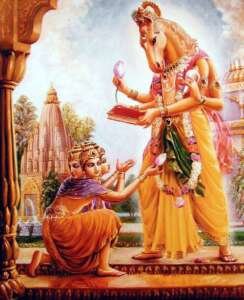
There are several stories about this unique avatar. One of the versions is that Vishnu revealed the Vedas to Brahma at the time of creation. Realizing the power of these Vedas, two demons Madhu and Kaitabha stole the Vedas from Brahma and hid them at the bottom of the ocean. When Brahma sought Vishnu’s help to retrieve the sacred texts, Vishnu took the Hayagreeva form, killed the two demons,and returned the Vedas to Brahma.
Another very interesting versionfound in Devi Bhagwat Purana is that demon named Hayagriva (one with the face of a horse), son of Kashyapa Prajapati, performed severe penance and obtained a boon from Goddess Durga, that he could be killed only by another “Hayagriva” and none other. Having got this boon, he grew arrogant and started creating havoc in Devaloka. The hapless Devasturned to Vishnu for deliverance from the evil and cruel demon. But the boon proved too powerful even to Vishnu as it was given by none other than the Supreme Goddess.
Even after a prolonged and fierce battle, the demon Hayagriva remained invincible. But the battle took its toll on Vishnu. He proceeded to Vaikuntha to recuperate and replenish His power and strength. It is said that He sat in Padmasana with His head resting on the upper end of His taut bow and got engrossed in deep meditation (Yoga Nidra).The Devas wanted Him to resume the battle but none could arouse Vishnu from His yogaNidra. So, Brahma thought of a plan. He created termites that would gnaw at the bowstring and when the string broke, the resonant sound created, would surely wake up the Lord.
The string snapped with the tremendous sound that reverberated through the entire universe, but because of the force with which it snapped, Vishnu’s head got severed from His body and fell into Lavan Sagar.Brahma’s plan had backfired and resulted in total disaster. The Devas were distressed and dismayed at the calamity. Their only hope now was to invoke the Mother Goddess. She had always protected them in times of dire need, time and again. So they prayed to Her and sought Her gracious help. Pleased with their prayers She assured them that there was a divine purpose behind this incident. Vishnu would get His form back once this purpose was achieved.
She instructed them to attach the head of a horse to Vishnu’s neck, who would then become a “Hayagreeva” and therefore in a position to slay the demon. Accordingly, Brahma attached the head of a white horse To Vishnu’s body and the revived Vishnu destroyed the demon. Later He resumed His usual form. The incarnation, Hayagriva, however, came to be worshiped and revered as the very personification of all knowledge, speech, and Vidya(education and the supremacy of the divine over the demoniac.
Hayagreeva’s blessings are sought when beginning the study of both sacred and secular subjects. Special worship is conducted on the day of the full moon in August (Śravaṇa-Paurṇamī) (his avatāra-Dina) and on Mahanavami, the ninth day of the festival. He is also hailed as “Hayashirasa”. Hayaśirṣa means haya=Horse, śhiraṣa=Head.
Compiled by Myra Desai
Kalki is an Avatara of Vishnu. Avatara means “Descent” and refers to a descent of the divine into the material realm of human existence. The Garuda Puran lists ten incarnations, with Kalki being the tenth. He is described as the incarnation who appears at the end of the Kali Yuga.
Kalki is born into the family of Sumati and Vishnuyasha, in a village called Shambala, on the twelfth day during the fortnight of the waxing moon.
Why did Lord Vishnu take Kalki Avatar?
The main motive of Lord Kalki would be to destroy all barbarians and thieves from the earth and make the earth peaceful place to live in. Apart from that, it is also said that Lord Kalki would defeat the Kings called to Koli and hand over the rule to Devapi and Maru the religious king of Koli yugas.
Lord Kapila
Kapila was the 10th child of sage Kardama and Princess Devahuti. As per the Vedas, Sage Kardama was provided a boon by Lord Narayana that he would himself be born as his son, attaining which Kardama had decided to leave for the forest for penance and research on Vedic studies. Kardama had nine daughters who were very learned and went ahead to marry great sages. Kapila was then born into great knowledge and wisdom.
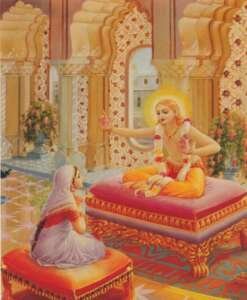 History
History
After Princess Devahuti had served her husband devotedly for many years, he offered to show his appreciation by sharing his wisdom with her. She reminded him that they had a duty to further the human race. Lord Krishna came to visit them and told them that their son, a manifestation of Vishnu, was to be named Kapila and would become a renowned sage. After his birth, with the permission of Kapila and Devahuti, Kardama took the vow of silence and went to live a life of meditation in the forests.
Lord Kapila is also a renowned sage and the author of the philosophical system known as Sankhya, which forms an important part of India’s ancient philosophical heritage.Kapila is described within the puranas as an incarnation of Vishnu, an avatar come to earth to restore the spiritual balance through his teachings. He is known for teaching a process of liberation known as bhakti yoga.
Krishna Avatar
Lord Vishnu is the “God who protects”. He is attributed to taking different avatars to protect the good, destroy the evil and restore dharma (righteousness). Krishna is one of the greatest avatars of Lord Vishnu.
The Avatar of Krishna is said to have taken place in Dwapara Yuga. His parents were Devaki and Vasudeva and he was born in the jail of his maternal uncle Kamsa who ruled the kingdom of Mathura. The King Kamsa was forewarned by his astrologers that his death would be caused by the eighth son of Devaki and hence when eight child Krishna was born he was secretly sent to Gokula(Vrindavan) where he was looked after by Yashoda and Nanda. The infant Krishna was adored by everyone in Gokula and he performed several miracles and killed demons.Krishna carried off the huge serpent Kalinga from the river to the sea. Sri Krishna also raised the Govardhana hill with his little finger and kept it as an umbrella to shield Vrindavan’s s people from the torrential rain caused by Lord Indra.Right from his boyhood, Krishna started playing flute. His music was extremely captivating. Not only human beings, but animals too were attracted by his flute.Gokula women, also known as Gopi’s were very fond of Krishna and Radha was his favorite. Radha-Krishna love has always been a source of inspiration for the Bhakti movement of Vaishnavaites.When he turned older, Lord Krishna and his brother Lord Balarama came back to Mathura and killed Kamsa, returning dharma to the land.He fell in love with a beautiful princess from the Vidarbha Kingdom, Rukmini. Lord Krishnamarried Rukmini and seven other wives, collectively known as Asthabharya.
 In the great war of Kurukshetra between the Kauravas (sons of Dhritarashtra) and the Pandavas (sons of Pandu), Krishna declined to bear arms. Still, he agreed to choose his presence on side of Pandavas and his army was lent to Kauravas. On Kurukshetra’s battlefield, Sri Krishna revealed the Bhagavad Gita to his disciple and friend Arjuna. Bhagavat Gita explains how an aspiring seeker could pursue a union with God. Sri Krishna also revealed his universal form (Vishwa rupa) to Arjuna, showing his full spiritual realization. It is the Gita that is an essential gift to the world of Krishna. Many believe that the whole object of the birth of Krishna was to deliver the Gita, which includes the advice of Krishna to Arjuna on the cusp of the Mahabharata War.Krishna came back to Dwarka after the Great War. He lived there until he got killed by an arrow which was mistakenly aimed at his foot by a hunter who thought it was a deer.
In the great war of Kurukshetra between the Kauravas (sons of Dhritarashtra) and the Pandavas (sons of Pandu), Krishna declined to bear arms. Still, he agreed to choose his presence on side of Pandavas and his army was lent to Kauravas. On Kurukshetra’s battlefield, Sri Krishna revealed the Bhagavad Gita to his disciple and friend Arjuna. Bhagavat Gita explains how an aspiring seeker could pursue a union with God. Sri Krishna also revealed his universal form (Vishwa rupa) to Arjuna, showing his full spiritual realization. It is the Gita that is an essential gift to the world of Krishna. Many believe that the whole object of the birth of Krishna was to deliver the Gita, which includes the advice of Krishna to Arjuna on the cusp of the Mahabharata War.Krishna came back to Dwarka after the Great War. He lived there until he got killed by an arrow which was mistakenly aimed at his foot by a hunter who thought it was a deer.
Krishna is always shown in a dark blue skin and he has peacock feather in his long black hair. The birth of Krishna is widely celebrated as Krishna Janmasthami where devotees offer milk sweets to baby Krishna.Krishna’s Bhagavat Gita reins as a supreme reference book for earnest seekers of Hinduism which provides guidance and enlightenment.
Kurma, (Sanskrit: “Tortoise”) one of the 10 avatars (incarnations) of the Hindu god Vishnu. In this incarnation Vishnu is associated with the myth of the churning of the ocean of milk. The gods and the asuras (demons) cooperated in the churning to obtain amrita, the elixir of immortality.
Lord Vishnu is believed to be the creator of all forms of life. The KurmaAvtaar is known to be the second avtaar of Lord Vishnu. The word Kurma stands for Tortoise. The turtle is known as the symbol of perseverance. The Avtaar is also known as Adi-KurmaAvtaar.
The Kurma avatar of Vishnu is usually represented in painting and sculpture in a mixed human-animal form. The human half, which is the upper half, is depicted wearing the same ornaments and holding the same weapons as in the usual images of Vishnu.
Kurma avatar belongs to the Satya Yuga and in thisavatara Mahavishnu incarnated as a giant turtle to save the earth from destruction. Kurma Avatar of dashavatar is explained mainly in the Bhagavad Purana, Agni Purana and Ramayana. Kurma Purana, one of the major eighteen Puranas, is said to have been directly stated by Lord Vishnu to the sage Narada, and it contains the details about the Kurma avatar.
How did Lord Vishnu save mankind by transforming into a tortoise (Kurma)?
Since the Danavas had defeated the Devas in the battle, there arose a need to empower the latter. Therefore, Lord Vishnu suggested Samudra Manthan for extracting the divine nectar (Amrit) that could make the Devas immortal. However, the Devas alone wouldn’t have been able to perform the massive task. Hence, Vishnu advised Indra, the King of the Devas to take help from Kalketu, the King of the Danavas.
Interestingly, Vishnu had also hatched a plan to prevent the Devas from consuming the Amrit. Subsequently, to churn the ocean (Samudra), Mandara Mountain was cut from its base and installed in the sea as the churning rod. And Vasuki, the King of Snakes, became the churning rope.But, since the base of the mountain couldn’t reach the seabed owing to the surging movement of the waves, Lord Vishnu decided to make his presence felt in the form of a Kurma.
Lord Vishnu took the form of a Kurma and went deep inside the sea to carry the Mandara mountain on his back. Thus, by enduring the weight on his back, Lord Vishnu ensured that the churning of the ocean takes place without any hurdles. And by helping the Devas in the endeavor to obtain the Amrit, Lord Vishnu saved the human race.
Images of Kurma
Mohini is the only female avatar of the Hindu god Vishnu. In the epic of the Mahabharata, she appears as a form of Vishnu, acquires the pot of Amrita (an elixir of immortality) from the thieving asuras (Demons), and gives it back to the devas (Gods), helping them retain their immortality.Mohini’s main objective is to trick those she encounters. She is worshipped throughout Indian culture, but mainly in Western India, where temples are devoted to her depicted as Mahalasa, the consort of Khandoba, a regional avatar of Shiva.
The Amrita, or nectar of immortality, is produced by the churning of the Ocean of Milk. The Devas and the Asuras fight over its possession. The Asuras contrive to keep the Amrita for themselves, angering the Devas. Vishnu, wise to their plan, assumes the form of an “enchanting damsel”. She uses her allure to trick the Asuras into giving her the Amrita, and then distributes it amongst the Devas. Rahu, an Asura, disguises himself as a god and tries to drink some Amrita himself. Surya (the sun-god) and Chandra (the moon-god) quickly inform Vishnu, and he uses the Sudarshana Chakra (the divine discus) to cut off the head of Rahu, leaving it immortal.
Mohini also has an active history in the destruction of demons throughout Hindu texts. In the Vishnu Purana, Mohini defeats Bhasmasura, the “ash-demon”Bhasmasura invokes Lord Shiva by performing severe penances. Shiva, pleased with Bhasmasura, grants him the power to turn anyone into ashes by touching their head. The demon decides to try the power on Shiva himself. Shiva prays to Vishnu for help and Vishnu transforms into Mohini and charms Bhasmasura. Bhasmasura is so taken by Mohini that he asks her to marry him. Mohini agrees, but only on the condition that Bhasmasura follows her moves in a dance. In the course of the dance, she places her hand on her own head. Bhasmasura mimics the action, and in turn, reduces himself to ashes.
Narada Muni, is a sage divinity, famous in Hindu traditions as a travelling musician and storyteller, who carries news and enlightening wisdom.
He is one of mind-created children of Brahma, the creator god. He appears in a number of Hindu texts, notably the Mahabharata, telling Yudhishtira the story of Prahlada and the Ramayana as well as in the Puranas.
Once God decided that it was time for Him to descend upon earth to set matters right, a number of lesser deities such as Narada accompanied Him to offer aid or enjoy a close view of epochal events. He is also referred to as Rishiraja, meaning the king of all sages. He was gifted with the boon of knowledge regarding the past, present, and the future.
Sage Narada
Joshini Shanmugam 7yr old
In Indian texts, Narada travels to distant worlds and realms. He is depicted carrying a khartal (musical instrument) and veena with the name Mahathi and is generally regarded as one of the great masters of the ancient musical instrument.
Divine Sage
Messenger of the gods
Sage Narada
Joshini Shanmugam 7yr old
Matysa
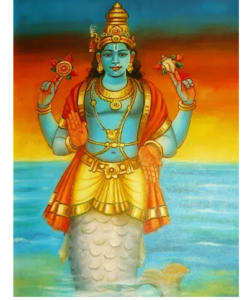 Matsya is the fish avatar of the God Vishnu. Often described as the first of Vishnu’s ten primary avatar.
Matsya is the fish avatar of the God Vishnu. Often described as the first of Vishnu’s ten primary avatar.
The Matsya Avatar comes into existence to save the highly pious king and the first man, Vaivasvatha Manu., this avatar advises Manu to build an ark to save all species from the great flood.
As per Bhagavata Purana, Lord Mahavishnu incarnated as Matsya to ensure the continuity of life on the earth following the great floods and also to rescue the Vedas and sacred texts from the demon Hayagriva.
Symbolic representation
Lord Matsya is depicted as a four-armed figure that is both man and a fish. The upper half is that of the four-armed man and the lower half is a fish. The upper half resembles Vishnu and wears the traditional ornaments and the kirita-mukuta (tall conical crown) as worn by Vishnu. He holds in two of his hands the Sudarshana chakra (discus) and a shankha (conch), the usual weapons of Vishnu. The other two hands make the gestures of varadamudra, which grants boons to the devotee, and abhayamudra, which reassures the devotee of protection.
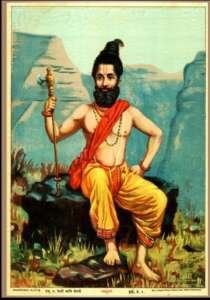 Parashurama also referred to as Rama Jamadagnya, Rama Bhargava and Veerarama, is the sixth incarnation among the Dashavatara of the god Vishnu in Hinduism. He is believed to be one of the Chiranjeevis (Long-Lived Ones or Immortal Ones), who will appear at the end of the Kali Yuga to be the guru of Vishnu’s tenth and last incarnation, Kalki. He carried a number of traits, which included not only aggression, warfare and valor, but also serenity, prudence and patience.
Parashurama also referred to as Rama Jamadagnya, Rama Bhargava and Veerarama, is the sixth incarnation among the Dashavatara of the god Vishnu in Hinduism. He is believed to be one of the Chiranjeevis (Long-Lived Ones or Immortal Ones), who will appear at the end of the Kali Yuga to be the guru of Vishnu’s tenth and last incarnation, Kalki. He carried a number of traits, which included not only aggression, warfare and valor, but also serenity, prudence and patience.
Born to Jamadagni and Renuka, Parashurama was foretold to appear at a time when overwhelming evil prevailed on the earth. The Kshatriya class, with weapons and power, had begun to abuse their power, take what belonged to others by force and tyrannise people. He corrected the cosmic equilibrium by destroying the Kshatriya warriors twenty-one times. He is married to Dharani, an incarnation of Lakshmi, the wife of Vishnu. He is present in the Ramayana due to the conflict with Rama (the protagonist of the Ramayana) over Lord Shiva’s broken bow. He is in the Mahabharata as the Guru of Bhisma, Drona, Rukmi and Karna.
Devansh Mittal
PRITHU
Prithu is celebrated as the first consecrated king, from whom the earth received her (Sanskrit) name prithvi.
He is mainly associated with the legend of his chasing the earth goddess, Prithvi, who fled in the form of a cow and eventually agreed to yield her milk as the world’s grain and vegetation.
Prithu means “large, great, important, abundant” is a chakravarthi , named in the vedic scriptures of ancient India. According to Hindu history, he is an incarnation of the preserver god Vishnu. He is also called Pruthu, Prithi and Prithu Vainya, literally Prithu — the son of Vena.
Prithu is celebrated as the first consecrated king, from whom the earth received her name Prithvi. He is mainly associated with the legend of his chasing the earth goddess, Prithvi, who fled in the form of a cow and eventually agreed to yield her milk as the world’s grain and vegetation. The epic Mahabharatha, Vishnu purana, Srimad Bhagavata purana describes the Avatar of Vishnu.
Harshini Shanmugam 10yr old
RAMA (or Ramacandra) is the seventh avatar of the Lord Vishnu.
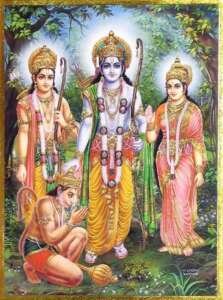 Lord Rama, is the most virtuous hero from Hindu mythology and he, along with his wife Sita, are a picture of purity and marital devotion.
Lord Rama, is the most virtuous hero from Hindu mythology and he, along with his wife Sita, are a picture of purity and marital devotion.
Rama’s father is King Dasaratha, a prince of the solar race, and his mother is Queen Kausalya. Rama was born at the end of the Second Age or Treta-yuga and he came into the world specifically at the bidding of the gods to deal with the fearsome multi-headed demon Ravana, the king of Lanka (modern Sri Lanka). Rama had three half-brothers – Bharata, Lakshmana, and Shatrughna – all with some, albeit lesser, divine qualities. Rama’s favourite brother and great companion was Laksmana, while his loyal servant was the monkey warrior Hanuman.
Rama’s first adventure occurred when the sage Visvamitra asked for help in fighting Taraka, a terrible female demon. His adventures continued and at Mithila, He won Sita’s (daugther of Janaka) hand in marriage when he bent the bow with his divine strength.
Rama’s succession to the throne of Ayodhya was made difficult by his mother’s hunchback slave Manthara. He was exiled from the kingdom for fourteen years. So, accompanied by Sita and his ever faithful companion Laksmana, Rama went to live in the far south in Citrakuta, deep in the Dandaka forest.
He ended up at Pancavati along the river Godavari, an area plagued by demons. One in particular, Surpanakha, the sister of Ravana,in an epic battle Rama defeated them all. She persuaded Ravana that Sita was a girl worth fighting for. Accordingly, the demon king sought out Rama’s home, abducted Sita,on aerial chariot to be kept captive in his beautiful Ashoka garden.
Rama followed in hot pursuit but met several troublesome distractions along the way.A series of titanic battles between Rama’s forces and the demons followed, but eventually Ravana was slain (with the help of Sugriva the monkey King and his army), Lanka fell to Rama’s army, and Rama was reunited with his wife. They are blessed with twin sons Lava and Kusha.
It is believed that Rama wades into the river Sarayu and from there is welcomed into heaven by Brahma.
In art Rama is always youthful and typically has green or blue skin, holds a bow and arrows, and wears a yellow robe. He is most often seen with Sita, Laksmana, and Hanuman – collectively known as Rama’s family.
RISHABA
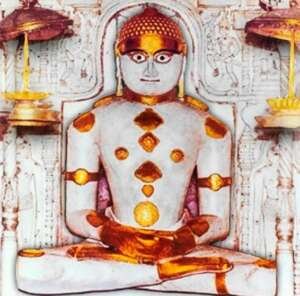 Among the 24 avatars of Vishnu mentioned in Srimad Bhagavad Purana, Rishabha Avatar is the 8th incarnation.
Among the 24 avatars of Vishnu mentioned in Srimad Bhagavad Purana, Rishabha Avatar is the 8th incarnation.
Rishabh Dev in Hinduism was the son of king Nabhi and Marudevi. He was a great ascetic who achieved control over the senses.
As per one account, Rishabh Dev later became the first Jain Tirthankara. He taught people the secret of Moksha or liberation.
The belief is that offering prayers to the Rishabha form of Vishnu will help couples in begetting healthy and intelligent children. He is also worshipped for healthy body.
VAMANA AVATAR
The Vamana Avatar starts with Mahabali, the Asura King. Mahabali was the grandson of Prahlada and the son of Virochana. Indra’s army defeated Bali and his army of Asuras and Daityas.
 One day Daityaraj Bali went to meet Rishi Shukracharya and asked him to show a way to gain back all powers and kingdom. The Acharya advised him to must perform a Yagya, to get back all powers. Bali agreed to do the Yagya under the supervision of Shukracharya. After the yagya, Bali received a golden chariot pulled by four houses that ran at the speed of wind. He also got a quiver with numerous arrows, a flag post with lion’s head and celestial armour. Along with these things, Shukracharya gave him a garland of ever blooming flowers and a conch shell whose battle cry was thunderous. Then Bali went to battle against Indra. This time Bali won the battle and Indra fled from the battlefield. Bali once again asked for Shukracharya’s guidance to maintain his victorious position. Shukracharya advised him to keep on performing yagyas and also give alms to poor and the Brahmins.
One day Daityaraj Bali went to meet Rishi Shukracharya and asked him to show a way to gain back all powers and kingdom. The Acharya advised him to must perform a Yagya, to get back all powers. Bali agreed to do the Yagya under the supervision of Shukracharya. After the yagya, Bali received a golden chariot pulled by four houses that ran at the speed of wind. He also got a quiver with numerous arrows, a flag post with lion’s head and celestial armour. Along with these things, Shukracharya gave him a garland of ever blooming flowers and a conch shell whose battle cry was thunderous. Then Bali went to battle against Indra. This time Bali won the battle and Indra fled from the battlefield. Bali once again asked for Shukracharya’s guidance to maintain his victorious position. Shukracharya advised him to keep on performing yagyas and also give alms to poor and the Brahmins.
Bali readily agreed to do so. Meanwhile Indra approached Acharya Brihaspati to learn a way to gain back Gods’ powers. Acharya Brihaspati asked Indra to seek Lord Vishnu’s help. Now Indra started doing penance so as to please Lord Vishnu. Maharishi Kashyap’s wife Aditi, who was Indra’s mother, saw her son in trouble and went to Lord Vishnu for help. Lord Vishnu promised to be born as her son and then kill Bali.
After Aditi gave birth to a boy, she named him Vamana. One day Vamana posed as a Brahmin and went to the spot where Shukracharya and Daityaraj Bali were performing a yagya. When asked what he could do to help, Vamana requested only three footsteps of land. Bali agreed despite being warned about Vamana’s true nature as Vishnu. Suddenly to everyone’s surprise, Vamana started growing in size and in three strides encompassed all existence and beyond. The three worlds are restored to Indra, and Bali and the Asuras are banished.
SAYAN – Age – 6 years
NARA NARAYANA
Nara-Narayana is a Hindu deity pair. Nara-Narayana is the twin brother avatar of the god Vishnu on Earth, working for the preservation of Dharma.
Nara-Narayana are depicted jointly or separately in images. When depicted separately, Nara is portrayed with 2 hands and wearing deerskin while Narayana is shown on the right in the ususal form of Vishnu. When depicted together, they are depicted identical to each other, with 4 arms holding a mace, conch, lotus.
Temple:
Nara- Narayan can be worshipped at Bhadrikaashrama at the sacred Badrinath Kshetra amidst the Himalayas.
VARAHA AVATAR
Varaha is the avatar of the Hindu god Vishnu, in the form of a boar. Varaha is generally listed as third in the Dashavatara, the ten principal avatars of Vishnu.
Varaha is most commonly associated with the legend of lifting the Earth (personified as the goddess Bhudevi) out of the cosmic ocean. When the demon Hiranyaksha stole the earth and hid her in the primordial waters, Vishnu appeared as Varaha to rescue her. Varaha slew the demon and retrieved the Earth from the ocean, lifting it on his tusks, and restored Bhudevi to her place in the universe.
Varaha may be depicted as completely a boar or with a boar’s head and the human body. His consort, Bhudevi, the earth, is often depicted as a young woman, lifted by Varaha.
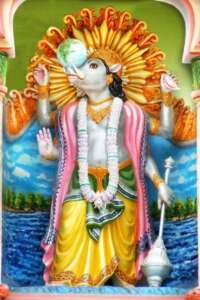 The deity Varaha derives its name from the Sanskrit word varāha meaning “boar” or “wild boar”.
The deity Varaha derives its name from the Sanskrit word varāha meaning “boar” or “wild boar”.
The origin of Varaha is found in the Vedas, the oldest Hindu scriptures. Varaha is originally described as a form of Prajapati (equated with Brahma), but evolved into the avatar of Vishnu in later Hindu scriptures.
The Varaha Avatar Story as in Puranas
The Varaha avatar starts with the Doorkeepers of Lord Vishnu. Lord Vishnu lived in Vaikunta. Vaikunta was guarded by two gatekeepers, Jaya and Vijaya. They loved Lord Vishnu and felt honoured that they were protecting him. They were many people who came to visit Lord Vishnu and it was Jaya’s and Vijaya’s job to allow every person who had grievance to see the Lord. They knew that Lord Vishnu’s time was precious and could not be wasted.
One day Lord Brahma’s four sons came to meet Lord Vishnu at his abode – Vaikunth. Since Lord Vishnu was resting at that time, the two guards named Jaya and Vijaya stopped them from entering the gates.Lord Brahma’s sons were very angry and they cursed Jaya and Vijaya to be born as humans on earth. Guards pleaded them but Lord Brahma’s son wouldn’t listen.
Lord Vishnu after hearing some noises arrived at the spot and apologized for his guards, saying they were just doing their duty.But the curse can’t be taken back saying this Lord Brahma’s sons left. Lord Vishnu then addressed his guards and said that curse would be lifted if you both in human forms would meet your death at my hands. The guards had no choice but to agree to this. Both the guards were born as brothers named Hiranyakashyap and Hiranyaksha.
Hiranyaksha was a great devotee of Lord Brahma. He worshiped him for years and in return Lord Brahma gave him a boon. According to the boon no God, human, Asura, devta, animal or beast would kill him. Hiranyaksha started torturing the people on earth as he was assured of his immortality. His powers grew by the day. He was such a giant that mother earth trembled when he walked and the sky cracked when he shouted.
He started harassing devtas and invaded Indra’s palace. Fearing for their lives, devtas took shelter in the caves of mountain ranges of earth. To harass devtas, Hiranyaksha grabbed earth and submerged it in paatal lok. Mother Earth sank to the bottom of the ocean.
At this time Manu and his wife Shatarupa was ruling over earth. Seeing this Manu & his wife came to Lord Brahma, bowed and said, “Father, tell us how we may serve you & ensure our happiness in this world and the next. Where should Shatarupa and I live as Mother earth is submerged in the ocean?”
Lord Brahma became worried and thought that mother earth should be rescued. He said, “Hiranyaksha will not be destroyed by me because I have granted him a boon. Let’s take help of Lord Vishnu!”
As Brahma meditated to Lord Vishnu, a tiny Boar fell from his nostrils. Wondering what that creature was, it grew and grew till it was a size of a large Mountain. It was Lord Vishnu and he said, “I will enter into the ocean to lift Mother earth out of it.” He took the form of a boar to kill Hiranyaksha because while getting the boon from Lord Brahma, among all the animals, Hiranyaksha forgot to mention boar as an animal.
Emitting a terrifying roar, he (Lord Vishnu in the form of Boar) took one mighty leap into the air and tore the clouds with its hoofs and dived to the bed of ocean in search of Mother earth. He reached the other end of the ocean and discovered in its depths Bhoomidevi (Mother Earth).
Meanwhile Hiranyaksha rushed to the sea shore where he encountered with Varuna, Lord of the ocean, and challenged him,”O supreme Lord! O guardian of the whole sphere! Come & have battle with me.” Varuna became very angry as he knew that at this moment Hiranyaksha was mightier than him so he curbed his anger and said, “I have given up fighting as I am too old. You must fight with Vishnu; none but he alone would be an equal opponent for you. Go seek him out.”
Suddenly Narad arrived there. Hiranyaksha asked him, “Do you know the whereabouts of Vishnu?” Narad told him that Lord Vishnu was in the ocean rescuing Mother Earth. Angry Hiranyaksha charged towards the ocean-bed.
Meanwhile the Boar had just dug his tusk into the ocean-bed and lifted Mother Earth onto it, and began rising towards the surface. Hiranyaksha rushed towards him with a mace in his hand saying, “You fraudulent fellow! Where are you carrying away the earth conquered by me? Stop or I’ll crush your head with this mace!”
Hiranyaksha challenged Lord Vishnu in the form of a Boar to have battle with him but Vishnu ignored all his warnings and continued rising to the surface. Seeing this Hiranyaksha gave a chase, but the boar didn’t even looked back.
Hiranyaksha said, “Wait! You impostor! I know you can defeat all with your magic power but at present you are near me and I’ll surely defeat you.” The boar escaped to put mother earth at a safe place.
To this, Hiranyaksha became very angry and shouted, “How can you run away like a coward? Return me my earth.” The earth was already frightened but seeing Hiranyaksha it began to tremble more.
Lord Vishnu in Varaha avatar brought earth over the surface of ocean and placed it gently on it’s axis and blessed her. He then turned to face Hiranyaksha. The demon threw his mace at the boar but the boar stepped aside and raised his mace. They fought for a long time with their mace.
Now Brahma warned Vishnu, “You’ve only an hour before the sunset. Destroy the demon before it’s dark so that he gets no opportunity to resort his black magic.” Hearing Brahma’s word’s Hiranyaksha hurled his mace towards Lord Vishnu but later flung it away. Having lost the mace, Hiranyaksha began hitting out with his fists on the chest of the boar.
Lord Vishnu in Varaha avatar hit Hiranyaksha hard on his face with his fist and tossed him in the air. He fell over his head and died on the spot. Manu got his earth back and the Gods got back their heaven.
In this way Lord Vishnu in Varaha avatar slayed Hiranyaksha and saved Mother Earth from harm.
Vyasa Avatar
Lord Vishnu incarnated himself as a sage Krishna Dvaipayana. He was the son of Parashara and Satyavati He recompiled the sacred texts of the Vedas so that they might become more easily understandable to men. It was thus that there came to be four Vedas. He came to be known as Vedavyasa because he had divided the Vedas. He also wrote eighteen Mahapurans and Mahabharat.
Image courtesy -Google
Here are some interesting facts about Veda Vyasa.
1. Birth of Veda Vyasa
Vyasa is also considered one of the seven Chiranjivi (long-lived, or immortals), who are still in existence according to Hindu belief. He was born by the end of Treta Yuga and observed the whole of Dwapar Yuga.
2. Who was Veda Vyasa born to?
As a young woman, Satyavati met the wandering sage Parashara while ferrying the latter across a river. The sage requested Satyavati to satisfy his sexual needs. She agreed only after he promised to bless her with the boon of ‘virginity intact,’ lifelong youth, and a bodily fragrance as strong as that of a musk deer.
3. Is Veda Vyasa the avatar of Lord Vishnu?
According to the “Vishnu Purana,” “Veda Vyasa” is a title applied to the compilers of the Vedas who are avatars of Vishnu. Twenty-eight people with the title of “Veda Vyasa” have appeared so far. He is believed to be one of the 24 avatars of Lord Vishnu.
4. Did Veda Vyasa write his literacy alone?
Technically, Lord Ganesha wrote down all of Ved Vyasa’s literacy under Vyasa’s dictation. Ved Vyasa is credited with scripting the Vedic knowledge into the written form with Ganesha as his scribe. He divided Vedic knowledge into 4 Vedas for easy comprehension. Such division was done once every few sages to make it easier for the people to grasp the spiritual knowledge. Ved Vyasa was divided the Vedas for the 28th time.
5. What relation did he have with other characters in Mahabharata?
Mother of Veda Vyasa, Satyavati, later married King Shantanu, the father of Bhishma. Her father, chief of fishermen, imposed the condition that her sons would inherit the throne. By then, Shantanu had already declared Bhishma as the prince and heir to the throne. To get Shantanu out of distress, his son Bhishma pledged to serve Satyavati’ s offspring. He was never to claim any right to the throne, which rightfully belonged to him. Therefore, Bhishma and Veda Vyasa are stepbrothers.
6. Which festival is celebrated after Veda Vyasa?
The festival of Guru Purnima is dedicated to him. It is also known as Vyasa Purnima, for it is the day believed to be both his birthday and the day he divided the Vedas.
Vyasa Mantra
Vyasa is praised equal to Vishnu and considered one of his Avatars.
Vyaasaaya Vishnu -Roopaaya, Vyaasa roopaaya Vishnave
Namo vai Brahma-nidhaye Vaasishtaaya Namo Namaha’ –says Vishnu Sahasranama.
“I salute Vyasa of Vashista’s lineage, who is the embodiment of Vishnu, nay, Vishnu Himself, who has realised all there is to realise”.
Lord Yajna is also known as Lord Yajneshwara. He is the 7th avatar of the Hindu God Vishnu. His parents were Rushi and Aguthi. The consort of Lord Yajna is Ma Dakshina. They both had twelve children. They were mentioned as the demigods.
Lord Yagna is the supreme deity, who discharged his duties in an excellent manner while he ruled the Indra Loka. He has also done a lot of fire sacrifices. He is also the friend of the Dhruva star. At the end of his life, Lord Yajna became the divine star Mrigashirsha.
Performing Yajna in our homes would please the divine gods and goddesses and we would get good strength and good memory power.
Avni Goyal
for Gurukulum – The Shloka Learning Centre
Balarama
Balarama is a Hindu god and the elder brother of Krishna.
He is particularly significant in the Jagannath tradition, as one of the triad deities. He is also known as Haladhara, Halayudha, Baladeva, Balabhadra and Sankarshana.
The first two epithets refer to his strength, and the next two associate him with Hala (Langala, “plough”) from his strong associations with farming and farmers, as the deity who used farm equipment as weapons when needed.
Balarama is sometimes described as incarnation of Shesha, the serpent associated with the god Vishnu; Krishna is regarded as an incarnation of Vishnu. Some traditions regard him as one of 10 principle avatars of Vishnu himself.
Balarama’s significance in the Indian culture has ancient roots. His image in artwork is dated to around the start of the common era, and in coins dated to the 2nd-century BCE. In Jainism, he is known as Baladeva and has been a historically significant farmer-related deity.
NARASIMHA
Narasimha is a fierce avatar of the Hindu god Vishnu, he is half lion and half man to destroy evil and end religious discrimination and calamity on Earth, protecting Dharma.
Narasimha is described as the God of Destruction, who destroys the entire universe when world is about to end due to its papa karma or bad deeds. Hence, he is known as Kala (time) or Mahakala (great-time) or Parakala (beyond time) as well. Narasimha is also described as the God of Yoga, in the form of Yoga-Narasimha.
Vishnu adapted into a mixed avatar that is neither man nor animal and kills the demon at the junction of day and night, inside and outside just to kill Hiranyakashipu.
Hiranyakashipu was rakshasa and brother of evil Hiranyaksha who had been previously defeated by Vishnu, and thus hated the Vishnu. Hiranyakashipu gained special powers by which he could not be killed during the day or night, inside or outside the house, any place in the world i.e., neither in sky nor on land nor in heaven nor in pataala, by any weapon, and by man, God, asura or animal. Endowed with this, he began to create chaos and havoc, harassing all devotees of Vishnu, including his own son.
Nine icons of Narasimha:
Prahladavarada: blessing Prahlada
Yogānanda-narasiṃha: serene, peaceful Narasimha teaching yoga
Guha-narasiṃha: concealed Narasimha
Krodha-narasiṃha: angry Narasimha
Vira-narasimha: warrior Narasimha
Malola-narasiṃha or Lakshmi-narasimha: with Lakshmi his wife
Jvala-narasiṃha: Narasimha emitting flames of wrath
Sarvatomukha-narasimha: many faced Narasimha
Bhishana-narasimha: ferocious Narasimha
Bhadra-narasimha: another fierce aspect of Narasimha
Mrityormrityu-narasimha: defeater of death aspect of Narasimha
Narasimha is a significant iconic symbol of creative resistance, hope against odds, victory over persecution, and destruction of evil. He is the destructor of not only external evil, but also one’s own inner evil of “body, speech, and mind” states Pratapaditya Pal.
In South Indian art – sculptures, bronzes, and paintings – Vishnu’s incarnation as Narasimha is one of the most chosen themes and amongst Avatars perhaps next only to Rama and Krishna in popularity.
Pancha Narasimha Kshetras are five places where lord narasimha appeared, he self-manifested deities. They are Sri Yogananda temple,Sri Lakshmi narasimha temple, Sri vajra narasimha temple, Sri panakala narasimha temple and Sri yoga narasimha Vedadri.

